PLANTING A NEW PEAR TREE
Planting a pear tree is a relatively simple matter but we suggest you consider the following points before going ahead. Each of them is explored in a little more detail below.
- Equipment required for planting – get it all ready before you start planting your tree.
- When your pear tree arrives – get it planted as soon as possible (both bare rooted and pot grown) but don’t plant in freezing or very wet weather.
- Soil conditions – pear trees are tolerant of soil conditions but they prefer a free draining, rich soil so some preparation will repay you in the future.
- Position – In full sun as far as possible and out of the way of strong winds. Avoid frost-pockets and if you can’t then pick your variety of pear tree carefully. Pear trees like moist soil but will not survive in water-logged ground so make sure you choose a position where water does not gather, especially in winter.
- Spacing – one of the easiest mistakes to make and one of the easiest to avoid is to get the spacing correct from nearby plants and trees.
- Protect from animal damage – rabbits, hares and deer can all strip the bark from your new tree in a matter of a couple of days so provide protection for vulnerable new bark when you plant a tree, see equipment required below.
EQUIPMENT REQUIRED
Before your tree arrives have the following equipment ready for planting it:
- A fork to dig out the planting hole.
- A support post and a plastic / rubber spacer tie specially designed to attach newly planted trees to your support post. The support post should be reasonably strong (about 8cm / 3in) wide and about 150cm / 5ft high.
- A heavy hammer or something similar to bang the post into the ground.
- For bare-rooted trees, a bucket full of water.
- Preferably a mulch to place around the tree when it is planted. This can be well rotted compost, bark chip or wood chip. A black plastic mulch can also be used, although make lots of holes in it to allow rain water to easily pass through the surface into the soil below.
- Two people make the job easier and quicker although it’s perfectly possible for one person to plant a young tree successfully.
- Some form of protection against rabbits and other animals for the lower part of the main stem. Never assume that rabbit proof fencing will protect your fruit trees! In winter when snow lies on the ground, rabbits become desperate for food and no fencing I know of is good enough to keep out a starving rabbit. For ideas on protective measures see this page here. Some are a bit extreme but it will give you ideas.
WHEN YOUR PEAR TREE ARRIVES
If you have more than one tree to plant then ensure that each tree is labelled to show which variety it is. Nothing is more annoying than having three or so fruit trees arrive then unpacking them only to find out that you can’t tell which is which! Remember, one young pear tree looks much the same as any other fruit tree.
Bare-rooted pear trees need to be planted as soon as possible after they arrive or when you bring them home. With container grown pear trees time is not quite so crucial but it’s definitely best to plant them as soon as possible. Plant on a frost-free day and when the soil is not frozen from previous cold weather. Don’t plant when the soil is very wet.
The British weather however is not always reliable and you may need to store your new tree for a week or so until the weather conditions are suitable. If you need to delay planting a bare-rooted tree then you will need to heel it in immediately it arrives until the weather is correct for planting. The principle behind “heeling in” is simple – get the tree into temporary soil which is moist and not frozen solid and store it there until the time is right.
Although the pear tree retailers almost insist on planting their trees immediately they arrive, and this is most definitely the best idea, heeling in is a well-established practice which will keep a bare-rooted tree in very good condition for at least a week and often more. The best way to heel in a young tree is to dig a hole in some well dug soil adding lots of compost to break up the soil and warm it if frozen. Then place the roots of the tree into the hole and cover with the dug soil / compost. The roots should be covered completely with the soil.
It’s not even absolutely essential to keep the tree upright, it can be on its side, slightly pointed upwards with a support to keep it off the ground, just make sure that the roots are well covered with firmed down moist soil. Water the soil well and make sure the tree is well-supported. Later when you are ready to plant it permanently remove the top soil with your hands and gently tease it out from the remaining soil.
If you need to store a container grown tree then make sure the soil in the pot is moist and store it out of direct sunlight and away from strong winds. Against the outside walls of a heated house or in an unheated greenhouse is probably the best place.
NEVER STORE A BARE-ROOTED OR CONTAINER GROWN TREE INDOORS! The conditions inside a house will dry the tree out faster than you can say “I love pears”!
POSITION
A very common problem when planting pear trees is to position them too near other trees or plants. This sometimes only becomes obvious three or four years later when your tree is well established and very difficult to move. The size of a pear tree depends on four factors:
- The rootstock is in most cases the key factor to the final size (height and spread) of your pear tree.
- The variety of pear tree. In most cases, varieties grow to approximately the same size but there are a some which are well known to grow larger compared to others on the same rootstock. For example perry pear trees tend to grow larger than average. Read up about any varieties you plan to plant and note if they tend to grow larger than normal and adjust the spacing around it accordingly.
- Growing conditions can affect the eventual size of your tree. In poor conditions, sandy and / or poor levels of nutrition, they well turn out to be a slightly smaller tree compared to one grown in substantial soil with high levels of nutrients.
- Pruning obviously affects the size of a tree. Regular pruning designed to reduce the eventual size of a pear tree can keep its size to about three-quarters of a normally pruned tree. Remember though that pruning of this type needs to repeated for ever. If you forget to prune well for a year or two the tree will simply grow back to its normal size.
Established pear trees are more than able to cope with planting of bedding plants and other shallow rooted plants near their base. However don’t plant other pear trees, shrubs or deep rooted plants in the same area. As a rule of thumb leave a pear tree about one and a half times its maximum spread clear of other deep rooted plants. The supplier of your tree should be able to give you a good idea of its maximum spread.
If this information is not forthcoming then some guesswork is required and you will only ever be able roughly estimate the space required. If you know the rootstock then a good estimate for spacing between other trees / large shrubs would be:
- Quince C rootstock – allow at least 3m (10ft) between trees
- Quince A rootstock – allow at least 3.5m (11ft) between trees
- Pyrodwarf rootstock – allow at least 4.5m (15ft) between trees
- Pyrus communis rootstock – allow at least 7m (23ft) between trees.
Note that the above are the distances between one tree trunk and the other, not the distance required between the final overall spread of the trees.
PROTECT FROM ANIMAL DAMAGE
Young tree bark is very attractive to rabbits, hares and deer to name but a few animals. If you live in an urban area, deer are unlikely to be a problem but in more exposed situations they can kill a young tree overnight.
Rabbits and hares are the easiest threat to deal with. Buy spiral tree guards and place them round the base of the tree trunk to protect from rabbits and hares. Remove the guards after a couple of years when the bark will have become hardened and unattractive to rabbits and hares.
To protect from deer damage you need to erect fencing / wire-mesh around the tree to prevent them getting anywhere near it. Do this immediately after planting if you have any suspicion that deer may be a problem.
HOW TO PLANT
Before you start to dig the planting hole make sure your tree is fully hydrated. If it’s a bare rooted tree then place the roots in a bucket of water while you dig the hole. If it’s a container grown tree then water the container well before digging the hole.
Dig a hole which is slightly wider than the container or two to three times as wide as the bare-roots ball and deep enough to take either so that the tree is to the same depth in the container or as it was, if bare-rooted, at the nursery. Bare-rooted trees will have a soil mark near the base of the trunk showing how deep they were planted.
For container grown trees remove the tree from the container disturbing the roots as little as possible. Place the tree in the dug hole and and check that the surrounding soil will be at the same level as the soil in the container – add or remove soil as required to achieve the correct height. Fill in the hole with soil firming it down as you go. Don’t apply too much pressure on the soil, just enough to ensure that any air gaps are filled with soil.
The same idea applies to bare-rooted trees but spread out the roots into the hole before adding soil. Place the tree to the correct depth in the hole (two people make this a lot easier) and gradually sprinkle on soil gently firming it down as more soil is added.
Finally water the soil around the tree very well. We recommend applying a mulch around the base of your pear tree but leave a gap of 3cm / 1 in or so of clear soil around the base of the trunk so that the mulch is not touching it. A mulch depth of 8cm / 3in and a spread of 1 metre / yard should be fine. It’s best to mulch a new pear tree after watering it and after the support stake has been put in place (see below, Supporting a New Pear Tree).
SUPPORTING A NEW PEAR TREE
Newly planted pear trees require support for the first couple of years until their roots are strong enough to support them. Some require support throughout their life, it all depends on the rootstock used. The more vigorous rootstocks require only two years support and by far the most common of these are Pyrodwarf and Pyrus communis in the UK.
It’s interesting to note that a one year old Pyrodwarf or Pyrus communis rootstock tree can probably get away with being planted with no support at all (if pruned correctly) except in very windy conditions or on light soil. However the same tree planted as a two or three year old needs support in the first couple of years. The reason is that the profile of a one year old tree is small and therefore wind resistance is minimal allowing it to grow sufficiently strong roots before it gets too large. A three year old tree however has a more developed branch structure and more foliage making it prone to wind damage in the first couple of years.
Quince A rootstock trees need support for the first three years of their life and Quince C trees need support throughout their lives.
The method of staking is the same whichever rootstock you have but of course a stake which is only required for a year or two can be of cheaper untreated wood whereas a stake for life should be treated to ensure it lasts as log as possible.
The stake should be about 150cm / 5ft high and 8cm / 3in thick and you should aim to have about 60cm / 2ft underground.
Drive the stake into ground (a largish hammer is essential for this) to a depth of about 60cm / 2ft at a 45% angle so that it crosses near, but does not touch, the pear tree stem about 60cm / 2ft high above ground level. The direction of the stake should be into the direction of the prevailing (the most common direction) wind.
The reason for the direction of the stake is to ensure that when the wind blows it will tend to secure the stake further into the ground rather than blow it over.
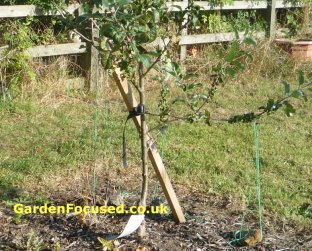
Use a proper tree stake tie to attach the tree to the stake so that the tree trunk does not rub against the stake which would cause damage. Tying the stake relatively low down the tree trunk will allow some movement in the tree trunk which will encourage the roots to develop and support the tree better.
WATERING YOUR PEAR TREE
Young trees, from one to three years old, are the most vulnerable to water shortages. Their roots are shallow and do not spread very far which can make finding water a problem for them.
Our advice on planting a new pear tree includes watering them well and applying a mulch immediately after planting. If the tree is planted in late autumn / winter then it should be left to its own devices as far as water is concerned until mid Spring time. There are two reasons for this, firstly for most of this time the tree will be dormant and will have minimum water requirements. Secondly the late autumn and winter weather will supply sufficient rain water for the tree’s needs.
In the first spring through to late autumn, water your tree if the ground conditions become dry. A simple test to determine if a young tree needs water is to use a trowel to dig into the soil to a depth of 3cm / 1in and see if the soil is damp. If it is then don’t water – too much watering can damage a pear tree.
If the soil needs watering then use lots of it once to ensure the water goes deep into the soil. Then leave the tree for at least two weeks before testing again. To effectively water a tree remove the mulch where you are going to water and then replace the mulch after watering.
The water absorbing roots of a very newly planted pear tree will be within a a metre / yard of the trunk but as the tree grows to a two and tree year old those roots will move out slightly so water an area slightly further away from the trunk but also slightly further away from the trunk.
For trees four years and older water requirements will depend on the rootstock used. More vigorous rootstocks such as Pyrodwarf and pyrus communis will never need watering, their root system will be wide and relatively deep. Less vigorous rootstocks such as Quince C will need to be watered when the soil becomes dry, in the height of a warm and dry UK summer this may require watering once every couple of weeks.
FEEDING PEAR TREES
Pear trees will survive with no feeding, especially those on more vigorous rootstocks but they will do better when fed twice a year. Feeding them will result in a better crop of fruit and also reduce their susceptibility to pest damage and diseases.
We recommend feeding with Blood Fish and Bone in early to mid Spring and then again in late autumn with the same. A major benefit of an organic fertiliser such as blood, fish and bone is that it is very unlikely to apply too much. Pear tree roots tend to absorb water and feed much better from soil which is at the edges of the tree canopy (foliage), and this gets further from the trunk as a tree ages.
For young trees sprinkle four or five handfuls of blood, fish and bone around the tree, but not touching the trunk, at both feed times. Increase the amount of feed as the tree becomes bigger. If it is applied to bare soil then work it lightly into the surface with a trowel and apply water. If it is applied on grass then rake it in lightly and then water.
RE-APPLY MULCH
Organic mulch applied around a tree will tend to be absorbed into the soil over the period of a year. Worms will do this by dragging the material down into the soil, water and general de-composition will also have the same effect. So it’s best to top up the mulch in mid Spring to its original level.
The purpose of a mulch is twofold, to reduce water loss and to suppress weeds which, if left unchecked, will use up moisture and nutrients for their own growth. For young trees (one to three year olds) the mulch should be applied to a depth of 8cm / 3in and a spread of 1 metre / yard. As the tree ages the water absorbing roots will spread out so the area covered by the mulch should increase as well. Water absorbing roots will spread at least as far as the the canopy (foliage) of the tree.
THINNING PEAR TREE FRUIT
The term “thinning” is the process of removing some of the very young fruit from a tree in order to encourage the remaining fruits to develop better. Most pear trees don’t need to be thinned although you may want to do this if your tree produces lots of pears with only a few reaching maturity.
Thin so that each blossom cluster only contains two fruits and the clusters are about 12cm / 5in apart. The best time to thin pear trees is when the the individual fruits are the size of a pea.
WHEN AND HOW TO HARVEST PEARS
Almost all pear trees only produce good fruit if you harvest just before they are ripe. If you leave a pear to ripen on the tree it will very, very quickly start to go mushy in the middle. The difficulty is knowing the time when they are just about to ripen. Colour and firmness are not good indicators of readiness to harvest, however there are a couple of methods of judging this and the simplest is to wait until a few pears drop to the ground and then start to harvest those that still remain on the tree.
Another method is to use the dates give on our pear varieties page for all the common pears grown in the UK. Be sure to follow the link on that page to set your home town to make the dates as accurate as possible. Be aware that the dates given are for an average year and may differ by a week or so but at least they give you an estimate. If you don’t know the variety of the pear you’ll be forced into assuming it’s mid-season for the first year’s harvest – the variety Gorham is a good example of a mid-season pear.
The final method of judging when a pear is ready to harvest, in conjunction with the dates found using the link in the paragraph above, is to take a pear in your hand and tilt it horizontally. If it’s ripe a very gentle pull should separate it from the branch. If it still doesn’t come off, leave it a few more days.
Having harvested your pears some can be moved to a room inside the house at a normal temperature and they should be ready for eating after four days or so. It’s a good idea to gently press a newly harvested pear near its neck. You will feel that’s the it’s firm with no “give” in it. Doing the same test three or four days later you should be able to feel that there is now some give in the flesh and that’s an indicator that the pear is ripe to eat.
To store pears which you don’t need immediately, place them in the fridge or a cool dark place for maximum storage life. When you need more pears bring some out of the fridge and into the house for the final ripening.
PEST PREVENTION
We have a unique page dedicated to identifying, treating and preventing pest and diseases of pear trees. Click here to go to that page now and feel free to ask any questions or post useful information about the subject.
COMMENTS / QUESTIONS LEFT BY OUR READERS
| Found the site one of the best I have seen every thing I need to know . thank you.
ANSWER: Thanks, glad you find it useful. |
We have temporarily disabled more questions because we are unable to cope with the workload of answering them at the moment. We are seeking more staff to help with this problem.


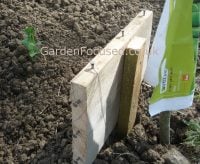
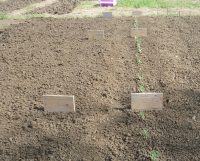

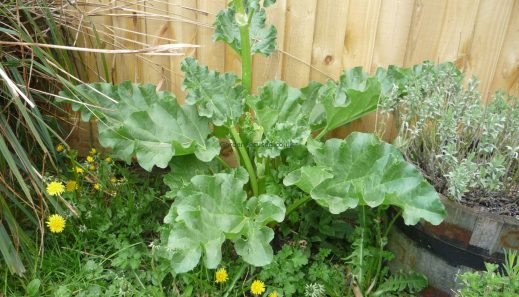



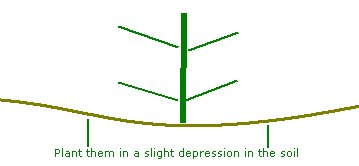




When and How to Sow Tomato Seed
Ongoing Care
Pruning Tomatoes
Pest and Disease
Tomato Nutrient Defficiency
Save Tomato Seeds
Tomato Variety Review
Tomato Question and Answer
HOW TO CARE FOR
OUTDOOR TOMATOES
Tomato plants are not complicated to grow well but they do benefit from regular care. Their first need is for regular watering in dry conditions. Without that they suffer from a variety of problems.Correct and regular feeding is key for the fruit to form well. They need different nutrients at different stages of their growth.Finally, pruning is key for cordon type tomato plants. Removing and pruning away dyeing and low-growing foliage benefits both cordon and bush tomato plants.